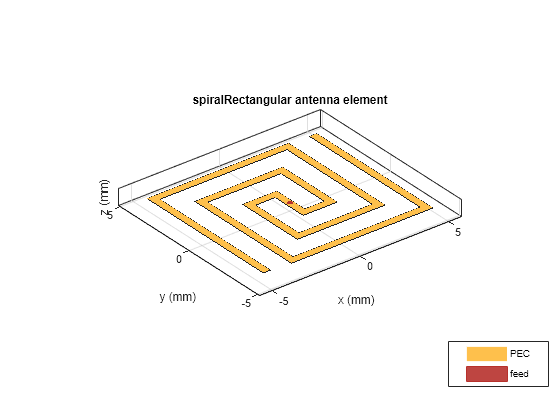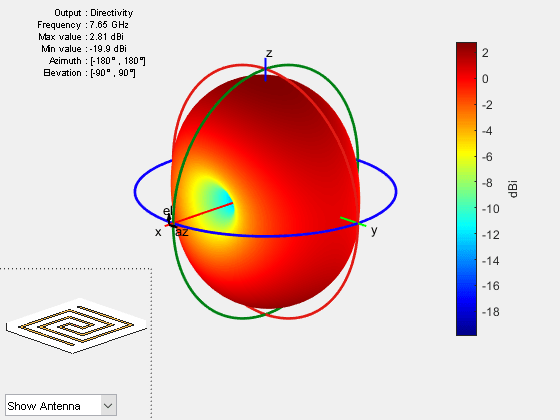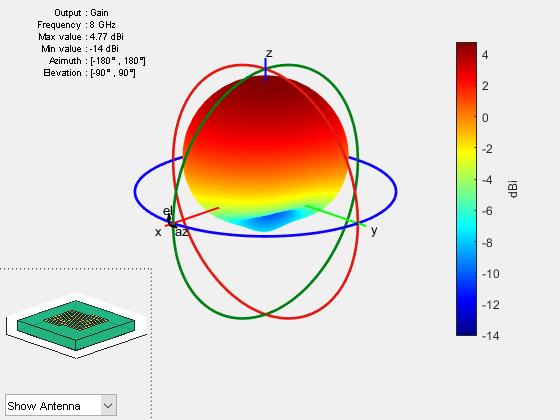spiralRectangular
Create rectangular spiral antenna on xy-plane
Description
The default spiralRectangular object creates a single or two-arm
rectangular spiral antenna resonating around 7.65 GHz. The default rectangular spiral
has two arms, is center-fed and is on the xy-plane.
A spiral rectangular antenna is made up of filaments. The distance between the two violet dashed lines in the diagram represents the first filament or the initial width. The distance between the two orange dashed lines in the diagram represents the second filament or the initial length.

Creation
Description
sr = spiralRectangular creates a default rectangular
spiral antenna object with default property values. The default dimensions
are chosen for an operating frequency of around 7.65 GHz.
sr = spiralRectangular(
sets properties using one or more name–value arguments.
PropertyName=Value)PropertyName is the property name and
Value is the corresponding value. You can specify
several name-value arguments in any order as
PropertyName1=Value1,...,PropertyNameN=ValueN.
Properties that you do not specify, retain their default values.
For example, sr = spiralRectangular(NumArms=1) creates
a planar rectangular spiral antenna with a single arm.
Properties
Object Functions
axialRatio | Calculate and plot axial ratio of antenna or array |
bandwidth | Calculate and plot absolute bandwidth of antenna or array |
beamwidth | Beamwidth of antenna |
charge | Charge distribution on antenna or array surface |
current | Current distribution on antenna or array surface |
design | Create antenna, array, or AI-based antenna resonating at specified frequency |
efficiency | Calculate and plot radiation efficiency of antenna or array |
EHfields | Electric and magnetic fields of antennas or embedded electric and magnetic fields of antenna element in arrays |
feedCurrent | Calculate current at feed for antenna or array |
impedance | Calculate and plot input impedance of antenna or scan impedance of array |
info | Display information about antenna, array, or platform |
memoryEstimate | Estimate memory required to solve antenna or array mesh |
mesh | Generate and view mesh for antennas, arrays, and custom shapes |
meshconfig | Change meshing mode of antenna, array, custom antenna, custom array, or custom geometry |
msiwrite | Write antenna or array analysis data to MSI planet file |
optimize | Optimize antenna and array catalog elements using SADEA or TR-SADEA algorithm |
pattern | Plot radiation pattern of antenna, array, or embedded element of array |
patternAzimuth | Azimuth plane radiation pattern of antenna or array |
patternElevation | Elevation plane radiation pattern of antenna or array |
peakRadiation | Calculate and mark maximum radiation points of antenna or array on radiation pattern |
rcs | Calculate and plot monostatic and bistatic radar cross section (RCS) of platform, antenna, or array |
rectspirallength2turns | Calculate number of turns for specified arm length in rectangular spiral antenna |
resonantFrequency | Calculate and plot resonant frequency of antenna |
returnLoss | Calculate and plot return loss of antenna or scan return loss of array |
show | Display antenna, array structures, shapes, or platform |
sparameters | Calculate S-parameters for antenna or array |
stlwrite | Write mesh information to STL file |
vswr | Calculate and plot voltage standing wave ratio (VSWR) of antenna or array element |
Examples
References
[1] Nakano, H., H. Yasui, and J. Yamauchi. “Numerical Analysis of Two-Arm Spiral Antennas Printed on a Finite-Size Dielectric Substrate.” IEEE Transactions on Antennas and Propagation 50, no. 3 (March 2002): 362–70. https://doi.org/10.1109/8.999628.
[2] Nakano, H., J. Eto, Y. Okabe, and J. Yamauchi. “Tilted- and Axial-Beam Formation by a Single-Arm Rectangular Spiral Antenna with Compact Dielectric Substrate and Conducting Plane.” IEEE Transactions on Antennas and Propagation 50, no. 1 (January 2002): 17–24. https://doi.org/10.1109/8.992557.
Version History
Introduced in R2020a




